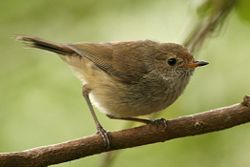Acanthizidae
| Acanthizidae | |
|---|---|
 | |
| Brown Thornbill (Acanthiza pusilla) | |
| Scientific classification | |
| Kingdom: | Animalia |
| Phylum: | Chordata |
| Class: | Aves |
| Order: | Passeriformes |
| Suborder: | Passeri |
| Superfamily: | Meliphagoidea |
| Family: | Acanthizidae Sundevall, 1872 |
| Genera | |
14, see list
| |
The Acanthizidae, also known as the Australasian warblers, are a family of passerinebirds which include gerygones, thornbills, and scrubwrens. The Acanthizidae consists of small to medium passerine birds, with a total length varying between 8 and 19 cm. They have short rounded wings, slender bills, long legs, and a short tail. Most species have olive, grey, or brown plumage, although some have patches of a brighter yellow. The smallest species of acanthizid, and indeed the smallest Australian passerine, is the Weebill, the largest is thePilotbird
Acanthizids are native to Australia, Indonesia, New Zealand, and the south-west Pacific. Most species are found in Australia and New Guinea, with Australia having 35 endemic species and New Guinea 15. A single species is found in Vanuatu, New Caledonia and the Solomon Islands, and three species occur in the New Zealand region, including endemic species in the Chatham Islands and Norfolk Island. In Asia two species are restricted to Indonesia and another is found in the Philippines and on mainland Asia. Most species are not migratory, with the exception of the gerygones. The family occupies a range of habitats from rainforests to arid deserts.Distribution
Behaviour
Most species are terrestrial, feeding primarily on insects, although also eating some seeds. In particular the whitefaces consume large numbers of seeds, and other species will take fruits. The secretions of sap-sucking insects are favoured by some species, as are the insects themselves. Some species are less terrestrial, such as the Weebill, which forages in the treetops, or the rock-dwelling Rockwarbler. Unusually for birds of their size, they lay only one or two eggs in a clutch, possibly because they are relatively long-lived, with many species living to over ten years of age in the wild.
Conservation status
Most taxa are considered as least concern. One species - the Lord Howe Gerygone (Gerygone insularis) - became extinct by rat predation in the early 1930s. The Norfolk Island Gerygone (Gerygone modesta) is vulnerable, and the Chestnut-breasted Whiteface (Aphelocephala pectoralis) is regarded as near threatened.
Taxonomy
Following the Sibley-Ahlquist taxonomy (1990) they were previously regarded as subfamily Acanthizinae within the Pardalotidae family. However, current revisions (Christidis & Boles, 1994; Schodde & Mason 1999) don't support this arrangement. The Dasyornithidae (which include the bristlebirds) are variously seen either as subfamily Dasyornithinae within the Acanthizidae or Pardalotidae family or as own family (Schodde & Mason 1999).
Genera
The Acanthizidae family consists of the two subfamilies Sericornithinae and Acanthizinae (Schodde & Mason 1999), 14 genera, 63 species and 196 taxa.
FAMILY: ACANTHIZIDAE
- Subfamily: Sericornithinae
- Genus: Pycnoptilus - Pilotbird
- Genus: Origma - Rockwarbler
- Genus: Oreoscopus - Fernwren
- Genus: Crateroscelis - Mouse-warblers (3 species)
- Genus: Sericornis - Scrubwrens (13 species)
- Genus: Acanthornis - Scrubtit
- Genus: Hylacola - Heathwrens (2 species)
- Genus: Calamanthus - Fieldwrens (2 species)
- Genus: Pyrrholaemus - (2 species)
- Subfamily: Acanthizinae
- Genus: Smicrornis - Weebill
- Genus: Gerygone - Gerygones (19 species, one now extinct)
- Genus: Acanthiza - Thornbills (13 species)
- Genus: Aphelocephala - Whitefaces (3 species)








No comments:
Post a Comment